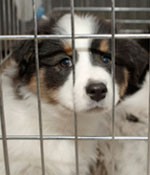What About Pets?
Without proper planning pets are likely to get injured, lost, or worse. Even if you decide to stay home, authorities may issue an evacuation order requiring you to leave at short notice. Public shelters cannot accept pets because of space and for health and safety concerns. It might be difficult, if not impossible, to find shelter for your animals right before a storm, so plan ahead.
Have a Safe Place to Take Them in Case you have to Leave Home:
Ask friends, relatives, or others whether they could shelter your animals. If you have more than one pet, they may be more comfortable if kept together, but be prepared to house them separately.
- Ask if your work place will allow you to shelter there with your pets.
- Some hotels will accept you with your pet. Call around to find out their policies and any restrictions on number, size, and species. Ask if "no pet" policies could be waived in an emergency.
- Keep a list of "pet friendly" places, including phone numbers, with other disaster information and supplies.
- If you have notice of an impending disaster, call ahead for reservations.
- If you decide to leave the island before the storm, the best thing to do is to evacuate your pets with you.
- Contact the Department of Agriculture well in advance to make sure your pet complies with all re-import requirements.
Assemble a Portable Pet Supplies Kit:
Like you, your pet will need essential supplies during and after the storm. Keep items in sturdy containers that can be carried easily (duffle bags, covered trash containers, etc.). Include:
- A first aid kit, including any medicines your pet is taking and their medical records.
- Sturdy leashes, harnesses, and/or carriers for transportation.
- Current photos of your pets in case they get lost.
- Food, potable water, bowls, cat litter and pan, and can opener.
- Information on feeding times, medical conditions, behavior problems, and the name and number of your veterinarian in case you have to foster or board your pets.
- Pet beds and toys, if easily transportable.
What to Do as the Storm Approaches:
- Call to confirm hotel reservations or shelter arrangements for you and your pets.
- Check that your pet disaster kit is ready to take at a moment's notice.
- Bring pets into the house to avoid searching for them if you have to leave.
- Dogs and cats must wear securely fastened collars with up-to-date identification. Write down your contact details on a temporary tag or put adhesive tape on the back of your pet's ID tag, adding information with an indelible pen.
If you Must Leave your Pet at Home:
- Prepare an area that is easily cleaned, such as a bathroom or utility room. Do not leave the animal near a window. Leave several days supply of dry food and water in non-spillable containers.
- If you are off island when a storm approaches, ask a trusted neighbor or friend to take care of your pets. It is best to arrange this before you travel in case a storm comes while you are away. This person should be comfortable with your pets, know where your animals are likely to be, know where your pet disaster supplies kit is kept, and have a key to your home.
Other Considerations:
Transporting Pets:
- Animals react differently under stress. Outside your home and in the car, keep dogs securely leashed. Transport cats in carriers. Don't leave animals unattended anywhere they can run off. The most trustworthy pets may panic, hide, try to escape, or even bite or scratch. And, when you return home, give your pets time to settle back into their routines. Call your veterinarian if any behavior problems last for more than a few days.
- Transport in a secure travel cage or carrier. Provide a few slices of fresh fruits and vegetables with high water content. Have a photo for identification and leg bands. If the carrier does not have a perch, line it with paper towels and change them frequently. Do not let the birds out of the cage or carrier.
- Small mammals (hamsters, gerbils, etc.) should be transported in secure carriers suitable for maintaining the animals while sheltered. Take bedding materials, food bowls, and water bottles.
- Horses and other livestock have a better chance of survival when turned out in clean pastures with native vegetation, but not in flood prone areas. Contact the Department of Agriculture for more information on sheltering farm animals.
Microchips to the rescue!
All dog owners in the Cayman Islands are required to have their dogs microchipped. The chip is a tiny and harmless electronic device inserted by a veterinarian just under the dog’s skin. It contains information to identify the dog and its owner and gives you the best chance of being reunited swiftly with your pet if it gets lost during a storm.
Taking your Pet Off-Island
Call the Agriculture Department well in advance to find out the requirements for taking your animal out of the country and for bringing it back in. Also, be sure to find out the requirements of the country to which you want to take the pet.

